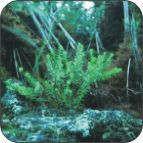Linum cratericola--this plant is endemic
to Floreana. It originated from just two sites in the middle of the island,
and has not spread far from the origin point since. These sites became covered
in Lantana camara, and L. cratericola was thought to be completely
extinct. (Mauchamp et al. 1996). In late 1996, about 25 adult individuals
were found on Floreana. They were subsequently fenced in and now the plant
is considered to be critically endangered (Tye 1997).

http://www.gct.org/botany1.html
Alternanthera nesiotes--this is a perennial plant that lives in the arid regions of Floreana. They take root on cones of brown balsaltic scoria (a dark volcanic rock with air bubbles, formed from volcanic eruptions); when goats overgrazed the area, A. nesiotes began to decline due to erosion. Twelve taxa of the genus Alternanthera are endemic (Mauchamp et al. 1996).
Psychotria angustata--this shrub, 2-3 m tall, lives in the humid zone of Floreana, anywhere from 250m to 500m above sea level. Two species in the genus are endemic to the Galapagos (Mauchamp et al. 1996).
Lippia salicifolia--this is a tree about 3-5 m tall. It lives in the humid zone of Floreana, within 250m to 500m above sea level (Mauchamp et al. 1996). It is endemic to Floreana, and is threatened by habitat loss, agriculture, livestock, Psidium guajava, and Lantana camara. As of 1998, about 2600 adult trees are still alive (many were felled to create space for new houses). Most of them live on Cerro de Pampa Bola (Mauchamp et al. 1998).
Lecocarpus lecocarpoides--this plant is endemic to Espanola. Declining populations are attributed to goats (Mauchamp et al. 1996).
The following table is from Mauchamp et al. (1996)'s article in Biodiversity and Conservation. It gives a general idea about the status of the listed endemic, endangered plants. Everything is from the article, except for the Red List status, which is more current.
**A note about pollination--the pollinating bee of the Galapagos Islands (Xylocopa darwini) lacks attractive nectar-producing flowers. They have been seen obtaining nectar from plants such as Clerodendron molle and Periloba galapagenis. Both plants have a deep, tube-like corollas, and are better adapted for pollination by moths. The bees' tongues are too short to reach the nectar. Instead, the bees bite into the bottom of the stem, creating a slit from which they obtain the nectar. In a study done in an area where 42% of the flora was endemic, it was found that only 27% of the plants visited by the bees were endemic. This significant difference shows that bees prefer the non-endemic plants. In particular, the bees like landing on yellow flowers (Thornton 1971). Lantana camara, one of the main invasive plants, has yellow flowers, which could be one of the reasons why it is so successful as an invasive species.

http://www.gct.org/botany1.html
Alternanthera nesiotes--this is a perennial plant that lives in the arid regions of Floreana. They take root on cones of brown balsaltic scoria (a dark volcanic rock with air bubbles, formed from volcanic eruptions); when goats overgrazed the area, A. nesiotes began to decline due to erosion. Twelve taxa of the genus Alternanthera are endemic (Mauchamp et al. 1996).
Psychotria angustata--this shrub, 2-3 m tall, lives in the humid zone of Floreana, anywhere from 250m to 500m above sea level. Two species in the genus are endemic to the Galapagos (Mauchamp et al. 1996).
Lippia salicifolia--this is a tree about 3-5 m tall. It lives in the humid zone of Floreana, within 250m to 500m above sea level (Mauchamp et al. 1996). It is endemic to Floreana, and is threatened by habitat loss, agriculture, livestock, Psidium guajava, and Lantana camara. As of 1998, about 2600 adult trees are still alive (many were felled to create space for new houses). Most of them live on Cerro de Pampa Bola (Mauchamp et al. 1998).
Lecocarpus lecocarpoides--this plant is endemic to Espanola. Declining populations are attributed to goats (Mauchamp et al. 1996).
The following table is from Mauchamp et al. (1996)'s article in Biodiversity and Conservation. It gives a general idea about the status of the listed endemic, endangered plants. Everything is from the article, except for the Red List status, which is more current.
| Species |
Island |
Reduction of Population |
Origin of Threat |
Regeneration |
IUCN Red List of Threatened Species Status |
| Linum cratericola |
Floreana |
Number |
Lantana camara |
None (as of 1996). Slight regeneration since 1997 |
Critically Endangered (1999) |
| Alternanthera nesiotes |
Floreana |
Size |
Goats, erosion |
Good |
Endangered (1999) |
| Psychotria angustata |
Floreana |
Size |
Pigs, Lantana camara |
Good |
Endangered (1999) |
| Lippia salicifolia |
Floreana |
Size |
Psidium guajava, Lantana camara |
Medium |
Vulnerable (1998) |
| Lecocarpus lecocarpoides |
Espanola |
Number |
Goats |
Good |
Vulnerable (1999) |
**A note about pollination--the pollinating bee of the Galapagos Islands (Xylocopa darwini) lacks attractive nectar-producing flowers. They have been seen obtaining nectar from plants such as Clerodendron molle and Periloba galapagenis. Both plants have a deep, tube-like corollas, and are better adapted for pollination by moths. The bees' tongues are too short to reach the nectar. Instead, the bees bite into the bottom of the stem, creating a slit from which they obtain the nectar. In a study done in an area where 42% of the flora was endemic, it was found that only 27% of the plants visited by the bees were endemic. This significant difference shows that bees prefer the non-endemic plants. In particular, the bees like landing on yellow flowers (Thornton 1971). Lantana camara, one of the main invasive plants, has yellow flowers, which could be one of the reasons why it is so successful as an invasive species.